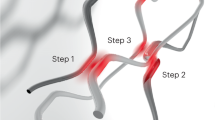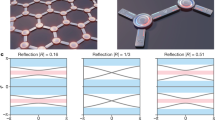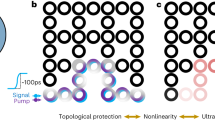Abstract
The interplay between topology and many-body physics has been a topic of strong interest in condensed matter physics for several years. For electronic systems, research has so far focused on linear topological phenomena due to the lack of a proper experimental platform and, in classical systems, due to the weak nature of nonlinear phenomena. Recently, it has been shown, however, that nonlinear effects can lead to unique phenomena, including self-induced topological states. Here we report nonlinear circuit arrays that exhibit self-induced topological protection. Our arrays are based on one-dimensional transmission-line circuits that emulate the Su–Schrieffer–Heeger model. We show that these nonlinear circuit arrays can exhibit self-induced topological transitions as a function of the input intensity, leading to topologically robust edge states that are immune to the presence of defects. The emergence of these topological states could lead to the design of electronic, optical and acoustic devices with functionalities that are highly tolerant to fabrication imperfections and unwanted parasitic effects.
This is a preview of subscription content, access via your institution
Access options
Access Nature and 54 other Nature Portfolio journals
Get Nature+, our best-value online-access subscription
$29.99 / 30 days
cancel any time
Subscribe to this journal
Receive 12 digital issues and online access to articles
$119.00 per year
only $9.92 per issue
Buy this article
- Purchase on Springer Link
- Instant access to full article PDF
Prices may be subject to local taxes which are calculated during checkout




Similar content being viewed by others
References
Hasan, M. Z. & Kane, C. L. Colloquium: Topological insulators. Rev. Mod. Phys. 82, 3045–3067 (2010).
Kim, D. et al. Surface conduction of topological Dirac electrons in bulk insulating Bi2Se3. Nat. Phys. 8, 459–463 (2012).
Bernevig, B. A., Hughes, T. L. & Zhang, S. C. Quantum spin Hall effect and topological phase transition in HgTe quantum wells. Science 314, 1757–1761 (2006).
Fu, L., Kane, C. & Mele, E. Topological insulators in three dimensions. Phys. Rev. Lett. 98, 106803 (2007).
Hsieh, D. et al. A topological Dirac insulator in a quantum spin Hall phase. Nature 452, 970–974 (2008).
Moore, J. & Balents, L. Topological invariants of time-reversal-invariant band structures. Phys. Rev. B 75, 121306 (2007).
Roy, R. Z 2 classification of quantum spin Hall systems: an approach using time-reversal invariance. Phys. Rev. B 79, 195321 (2009).
Qi, X.-L. & Zhang, S.-C. Topological insulators and superconductors. Rev. Mod. Phys. 83, 1057–1110 (2011).
Haldane, F. & Raghu, S. Possible realization of directional optical waveguides in photonic crystals with broken time-reversal symmetry. Phys. Rev. Lett. 100, 013904 (2008).
Wang, Z., Chong, Y., Joannopoulos, J. D. & Soljačić, M. Observation of unidirectional backscattering—immune topological electromagnetic states. Nature 461, 772–775 (2009).
Hafezi, M., Mittal, S., Fan, J., Migdall, A. & Taylor, J. M. Imaging topological edge states in silicon photonics. Nat. Photon. 7, 1001–1005 (2013).
Rechtsman, M. C. et al. Photonic Floquet topological insulators. Nature 496, 196–200 (2013).
Schomerus, H. Topologically protected midgap states in complex photonic lattices. Opt. Lett. 38, 1912–1914 (2013).
Khanikaev, A. B. et al. Photonic topological insulators. Nat. Mater. 12, 233–239 (2013).
Zeuner, J. M. et al. Observation of topological transition in the bulk of a non-Hermitian system. Phys. Rev. Lett. 115, 040402 (2015).
Mittal, S. et al. Measurements of topological invariants in a 2D photonic system. Nat. Photon. 10, 180–183 (2016).
Peano, V., Brendel, C., Schmidt, M. & Marquardt, F. Topological phases of sound and light. Phys. Rev. X 5, 031011 (2015).
Yang, Z. et al. Topological acoustics. Phys. Rev. Lett. 114, 114301 (2015).
Xiao, M. et al. Geometric phase and band inversion in periodic acoustic system. Nat. Phys. 11, 240–244 (2015).
Khanikaev, A. B., Fleury, R., Mousavi, S. H. & Alù, A. Topologically robust sound propagation in an angular-momentum-biased graphene-like resonator lattice. Nat. Commun. 6, 8260 (2015).
Ningyuan, J., Owens, C., Sommer, A., Schuster, D. & Simon, J. Time- and site-resolved dynamics in a topological circuit. Phys. Rev. X 5, 021031 (2015).
Albert, V. V., Glazman, L. I. & Jiang, L. Topological properties of linear circuit lattices. Phys. Rev. Lett. 114, 173902 (2015).
Roushan, P. et al. Chiral ground-state currents of interacting photons in a synthetic magnetic field. Nat. Phys. 13, 146–151 (2017).
Hadad, Y., Khanikaev, A. B. & Alù, A. Self-induced topological transitions and edge states supported by nonlinear staggered potential. Phys. Rev. B 93, 155112 (2016).
Hadad, Y., Vitelli, V. & Alù, A. Solitons and propagating domain walls in optical resonator arrays. ACS Photon. 4, 1974–1979 (2017).
Lumer, Y., Plotnik, Y., Rechtsman, M. C. & Segev, M. Self-localized states in photonic topological insulator. Phys. Rev. Lett. 111, 243905 (2013).
Leykam, D. & Chong, Y. D. Edge solitons in nonlinear photonic topological insulator. Phys. Rev. Lett. 117, 143901 (2016).
Heeger, A. J., Kivelson, S., Schrieffer, J. R. & Su, W. P. Solitons in conducting polymers. Rev. Mod. Phys. 60, 781–823 (1988).
Zak, J. Berry’s phase for energy bands in solids. Phys. Rev. Lett. 62, 2747–2750 (1989).
Xiao, M., Zhang, Z. Q. & Chan, C. T. Surface impedance and bulk band geometric phases in one dimensional systems. Phys. Rev. X 4, 021017 (2014).
Freeman, R. H. & Karbowiak, A. E. An investigation of nonlinear transmission lines and shock waves. J. Phys. D 10, 633–643 (1977).
Wilson, C. R., Turner, M. M. & Smith, P. W. Pulse sharpening in a uniform LC ladder network containing nonlinear ferroelectric capacitors. IEEE Trans. Electron. Dev. 38, 767–771 (1991).
Hanamura, E. Rapid radiative decay and enhanced optical nonlinearity of exitons in a quantum well. Phys. Rev. B 38, 1228–1234 (1988).
Lee, J. et al. Giant nonlinear response from plasmonic metasurfaces coupled to intraband transitions. Nature 511, 66–69 (2014).
Acknowledgements
This work was supported by the National Science Foundation, the Air Force Office of Scientific Research and the Simons Foundation.
Author information
Authors and Affiliations
Contributions
All authors conceived the idea. Y.H. developed the theory and the basic circuit design. J.C.S. optimized the circuit and designed the circuit layout. Y.H. and J.C.S. designed the experimental set-up and performed the measurements. All authors discussed the results and wrote the paper.
Corresponding author
Ethics declarations
Competing interests
The authors declare no competing interests.
Additional information
Publisher’s note: Springer Nature remains neutral with regard to jurisdictional claims in published maps and institutional affiliations.
Supplementary information
Supplementary Information
Supplementary Figures 1–3 and Supplementary Notes 1–8
Rights and permissions
About this article
Cite this article
Hadad, Y., Soric, J.C., Khanikaev, A.B. et al. Self-induced topological protection in nonlinear circuit arrays. Nat Electron 1, 178–182 (2018). https://doi.org/10.1038/s41928-018-0042-z
Received:
Accepted:
Published:
Issue Date:
DOI: https://doi.org/10.1038/s41928-018-0042-z
This article is cited by
-
Realization of all-band-flat photonic lattices
Nature Communications (2024)
-
Observation of non-reciprocal harmonic conversion in real sounds
Communications Physics (2023)
-
Spin-dependent properties of optical modes guided by adiabatic trapping potentials in photonic Dirac metasurfaces
Nature Nanotechnology (2023)
-
Two optimized novel potential formulas and numerical algorithms for \(m\times n\) cobweb and fan resistor networks
Scientific Reports (2023)
-
Realization of Wilson fermions in topolectrical circuits
Communications Physics (2023)



